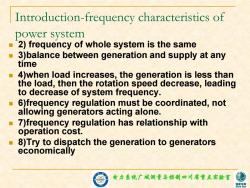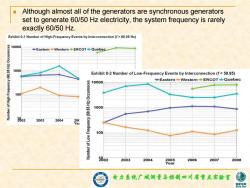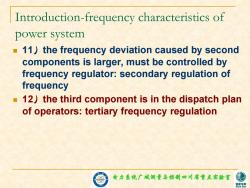电子科技大学:《电力系统运行与控制 Power System Operation and Control》课程教学资源(课件讲稿)Lecture 05 Power Generation Control and Frequency Regulation

Lecture 5 Generation control and frequency regulation Dr.Qi Huang School of Energy Science and Engineering UESTC
Lecture 5 Generation control and frequency regulation Dr. Qi Huang School of Energy Science and Engineering UESTC

Contents Introduction ■Mathematical model Generator model Load model Prime mover model ▣ Governor model a Tie-line model ■Automatic Generation Control(AGC:自动发电 控制) 电力拿镜广城洲量写控制四川省重点实验蜜 家电
电力系统广域测量与控制四川省重点实验室 Contents Introduction Mathematical model Generator model Load model Prime mover model Governor model Tie-line model Automatic Generation Control (AGC:自动发电 控制)

Introduction-frequency characteristics of power system 1)the rotation speed of an interconnected generator has a relationship between the system frequency: pn f= 60 Where:P-no.of pole of the generator n-revolution per minite (r/min fsystem frequency (Hz) It is clear that the frequency control is actually the regulation of the rotation speed of generator 电力拿镜广城洲量写控制四川省童点实验蜜 家电网
电力系统广域测量与控制四川省重点实验室 Introduction-frequency characteristics of power system 1)the rotation speed of an interconnected generator has a relationship between the system frequency: Where: P——no. of pole of the generator n ——revolution per minite(r/min) f——system frequency(Hz) It is clear that the frequency control is actually the regulation of the rotation speed of generator 60 pn f

Introduction-frequency characteristics of power system 2)frequency of whole system is the same 3)balance between generation and supply at any time ■ 4)when load increases,the generation is less than the load,then the rotation speed decrease,leading to decrease of system frequency. 6)frequency regulation must be coordinated,not allowing generators acting alone. ■ 7)frequency regulation has relationship with operation cost. ■ 8)Try to dispatch the generation to generators economically 电力拿镜广城洲量写控制四川省重点实验蜜 国家电网
电力系统广域测量与控制四川省重点实验室 2) frequency of whole system is the same 3)balance between generation and supply at any time 4)when load increases, the generation is less than the load, then the rotation speed decrease, leading to decrease of system frequency. 6)frequency regulation must be coordinated, not allowing generators acting alone. 7)frequency regulation has relationship with operation cost. 8)Try to dispatch the generation to generators economically Introduction-frequency characteristics of power system

Introduction-load and frequency 20 variation Actual load profile 10 15 20 time of the day (hours) 50.5 50 49.5 Measured frequency variation curve 48.5 48 8日”月月器号用8888天昌88除日日日88过8且8温88g 院广城测量与控制四川省重点实验蜜 家电
电力系统广域测量与控制四川省重点实验室 Introduction-load and frequency variation Actual load profile Measured frequency variation curve

Although almost all of the generators are synchronous generators set to generate 60/50 Hz electricity,the system frequency is rarely exactly 60/50 Hz Exhibit 0-1 Number of High-Frequency Events by Interconnection(f>60.05 Hz) 10000 Eastern●Vestern◆ERCOT◆Quebec 1000 Exhibit 0-2 Number of Low-Frequency Events by Interconnection(f<59.95) 10000 ◆Eastern。NWestern◆ERCOT◆Quebec 100 1000 802 2003 2004 0 100 802 2003 2004 2005 2006 2007 2008 Year 电力拿镜广城洲量写控制四川省童点实验蜜 家电
电力系统广域测量与控制四川省重点实验室 Although almost all of the generators are synchronous generators set to generate 60/50 Hz electricity, the system frequency is rarely exactly 60/50 Hz

It is not necessary to maintain the same frequency in the whole system.The power system can be partitioned into many (four in North America) interconnections that maintain their own frequency as close to 60/50 Hz as possible.The partitioning and different interconnection frequencies are achieved by using high voltage direct current (HVDC)lines and back-to-back HVDC links.HVDC lines have AC/DC and DC/AC converters at both ends of the line allowing for different frequencies. Exhibit 1-1 North American Interconnections interconnection Quebec Eastem Interconnection interconnection Westem Texas Interconnection 实验蜜 Source:NERC 20096 家电
电力系统广域测量与控制四川省重点实验室 It is not necessary to maintain the same frequency in the whole system. The power system can be partitioned into many (four in North America) interconnections that maintain their own frequency as close to 60/50 Hz as possible. The partitioning and different interconnection frequencies are achieved by using high voltage direct current (HVDC) lines and back-to-back HVDC links. HVDC lines have AC/DC and DC/AC converters at both ends of the line allowing for different frequencies

Introduction-frequency characteristics of power system 9)the load variation can be categorized into three components: Stochastic components:period less than 10s Fluctuating components:period 10s~3min Sustained components:period >3min;load prediction can forecast this component. 10)governor acts to regulate the output of the prime mover for the frequency deviation caused by first component:primary frequency control 电力拿镜广城洲量写控制四川省重点实验蜜 家电网
电力系统广域测量与控制四川省重点实验室 9)the load variation can be categorized into three components: Stochastic components: period less than 10s Fluctuating components: period 10s~3min Sustained components: period >3min; load prediction can forecast this component. 10)governor acts to regulate the output of the prime mover for the frequency deviation caused by first component: primary frequency control Introduction-frequency characteristics of power system

Introduction-frequency characteristics of power system 11)the frequency deviation caused by second components is larger,must be controlled by frequency regulator:secondary regulation of frequency 12)the third component is in the dispatch plan of operators:tertiary frequency regulation 电力镜广城测量与控制四川省重点实验蜜 家电网
电力系统广域测量与控制四川省重点实验室 11)the frequency deviation caused by second components is larger, must be controlled by frequency regulator: secondary regulation of frequency 12)the third component is in the dispatch plan of operators: tertiary frequency regulation Introduction-frequency characteristics of power system

Introduction ED and UC establish the optimal operation point based on economic consideration (how to implement it?) Operation point is implemented by generation control: Local control of every generator 口 Large system control and interconnection control at operation center Area control of multiple power network and Independent Power Produces (IPP's) ISO-Independent System Operator RTO-Regional Transmission System Operator 电力镜广城测量乌控制四川省重点实验蜜 家电网
电力系统广域测量与控制四川省重点实验室 Introduction ED and UC establish the optimal operation point based on economic consideration (how to implement it?) Operation point is implemented by generation control: Local control of every generator Large system control and interconnection control at operation center Area control of multiple power network and Independent Power Produces (IPP’s) ISO - Independent System Operator RTO - Regional Transmission System Operator
按次数下载不扣除下载券;
注册用户24小时内重复下载只扣除一次;
顺序:VIP每日次数-->可用次数-->下载券;
- 电子科技大学:《电力系统运行与控制 Power System Operation and Control》课程教学资源(课件讲稿)Lecture 04 Unit Commitment in Power System.pdf
- 电子科技大学:《电力系统运行与控制 Power System Operation and Control》课程教学资源(课件讲稿)Lecture 03 Power System Economic Dispatch.pdf
- 电子科技大学:《电力系统运行与控制 Power System Operation and Control》课程教学资源(课件讲稿)Lecture 02 Introduction.pdf
- 电子科技大学:《电力系统运行与控制 Power System Operation and Control》课程教学资源(课件讲稿)Lecture 01 Introduction of the course(黄琦).pdf
- 银川能源学院(银川大学):《电力系统分析》课程教学资源(课件讲稿)第9章 电力系统稳定性分析.pdf
- 银川能源学院(银川大学):《电力系统分析》课程教学资源(课件讲稿)第8章 电力系统不对称故障分析.pdf
- 银川能源学院(银川大学):《电力系统分析》课程教学资源(课件讲稿)第7章 电力系统不对称运行分析方法.pdf
- 银川能源学院(银川大学):《电力系统分析》课程教学资源(课件讲稿)第6章 电力系统三相短路故障分析.pdf
- 银川能源学院(银川大学):《电力系统分析》课程教学资源(课件讲稿)第5章 电力系统功率平衡与控制.pdf
- 银川能源学院(银川大学):《电力系统分析》课程教学资源(课件讲稿)第4章 复杂电力系统潮流计算.pdf
- 银川能源学院(银川大学):《电力系统分析》课程教学资源(课件讲稿)第3章 简单电力系统潮流分析.pdf
- 银川能源学院(银川大学):《电力系统分析》课程教学资源(课件讲稿)第2章 电力系统元件等效电路和参数.pdf
- 银川能源学院(银川大学):《电力系统分析》课程教学资源(课件讲稿)第1章 电力系统概述(李莉).pdf
- 银川能源学院(银川大学):《电力系统分析》课程教学资源(讲稿)电力线路等效电路及参数.pdf
- 银川能源学院(银川大学):《电力系统分析》课程教学资源(电子教案,共八章).pdf
- 银川能源学院(银川大学):《电力系统分析》课程教学资源(说课稿,李莉).pdf
- 东莞理工学院:《锅炉原理》课程教学资源(教学大纲)陈佰满-葛亚-2019级能源与动力工程1-2班.pdf
- 东莞理工学院:《计算流体力学》课程教学资源(教学大纲)杨小平,陈捷超-2018能源1,2班,建能1班.pdf
- 东莞理工学院:《节能原理与技术》课程教学资源(教学大纲)何清,陈佰满-2019级能源与动力工程1、2班,建筑环境与能源应用1班.pdf
- 东莞理工学院:《能源工程与管理》课程教学资源(教学大纲)陈捷超-2019能源1,2班,建能1班.pdf
- 电子科技大学:《电力系统运行与控制 Power System Operation and Control》课程教学资源(课件讲稿)Lecture 06 Power System Reactive Power and Voltage Control.pdf
- 电子科技大学:《电力系统运行与控制 Power System Operation and Control》课程教学资源(课件讲稿)Lecture 07 Power System Wide-area Measurement and Control.pdf
- 电子科技大学:《电力系统运行与控制 Power System Operation and Control》课程教学资源(课件讲稿)Lecture 08 power system state estimation.pdf
- 电子科技大学:《电力系统运行与控制 Power System Operation and Control》课程教学资源(课件讲稿)Lecture 09 Power System Optimal Power Flow.pdf
- 电子科技大学:《电力系统运行与控制 Power System Operation and Control》课程教学资源(课件讲稿)Lecture 10 Power System Security.pdf
- 《电力系统运行与控制 Power System Operation and Control》课程参考书籍文献:《Operation and Control in Power Systems》PDF电子书(Prof. P. S. R. MURTY).pdf
- “十四五”可再生能源发展规划(发布稿).pdf
- 电子科技大学:《物理与化学电源基础 Fundamental of Physical and Chemical Power Sources》课程教学资源(课件讲稿,第二部分)Lecture 01 Background of Batteries(陈俊松).pdf
- 电子科技大学:《物理与化学电源基础 Fundamental of Physical and Chemical Power Sources》课程教学资源(课件讲稿,第二部分)Lecture 02 Introduction of Lithium Batteries.pdf
- 电子科技大学:《物理与化学电源基础 Fundamental of Physical and Chemical Power Sources》课程教学资源(课件讲稿,第二部分)Lecture 03 Lithium-ion Batteries(LiCoO).pdf
- 电子科技大学:《物理与化学电源基础 Fundamental of Physical and Chemical Power Sources》课程教学资源(课件讲稿,第二部分)Lecture 04 Cathode material for LIBs(LiFePO4).pdf
- 电子科技大学:《物理与化学电源基础 Fundamental of Physical and Chemical Power Sources》课程教学资源(课件讲稿,第二部分)Lecture 05 Cathode material for LIBs(Li-Mn-O and NCM).pdf
- 电子科技大学:《物理与化学电源基础 Fundamental of Physical and Chemical Power Sources》课程教学资源(课件讲稿,第二部分)Lecture 06 Anode material for LIBs(Graphite).pdf
- 电子科技大学:《物理与化学电源基础 Fundamental of Physical and Chemical Power Sources》课程教学资源(课件讲稿,第二部分)Lecture 07 Anode material for LIBs(Lithium).pdf
- 电子科技大学:《物理与化学电源基础 Fundamental of Physical and Chemical Power Sources》课程教学资源(课件讲稿,第一部分)Section I Background and Fuel Cell(陈俊松).pdf
- 电子科技大学:《物理与化学电源基础 Fundamental of Physical and Chemical Power Sources》课程教学资源(课件讲稿,第一部分)Section II Nuclear energy(Fundamentals of Fusion Enery).pdf
- 电子科技大学:《物理与化学电源基础 Fundamental of Physical and Chemical Power Sources》课程教学资源(课件讲稿,第一部分)Section III Fundamentals of Solar Cell.pdf
- 电子科技大学:《物理与化学电源基础 Fundamental of Physical and Chemical Power Sources》课程教学资源(课件讲稿,第一部分)Section IV THERMODYNAMICS.pdf
- 电子科技大学:《物理与化学电源基础 Fundamental of Physical and Chemical Power Sources》课程教学资源(课件讲稿,第二部分)Lecture 10 Anode material for LIB(TiO2).pdf
- 电子科技大学:《物理与化学电源基础 Fundamental of Physical and Chemical Power Sources》课程教学资源(课件讲稿,第二部分)Lecture 11 Safety of Li-ion Batteries.pdf
